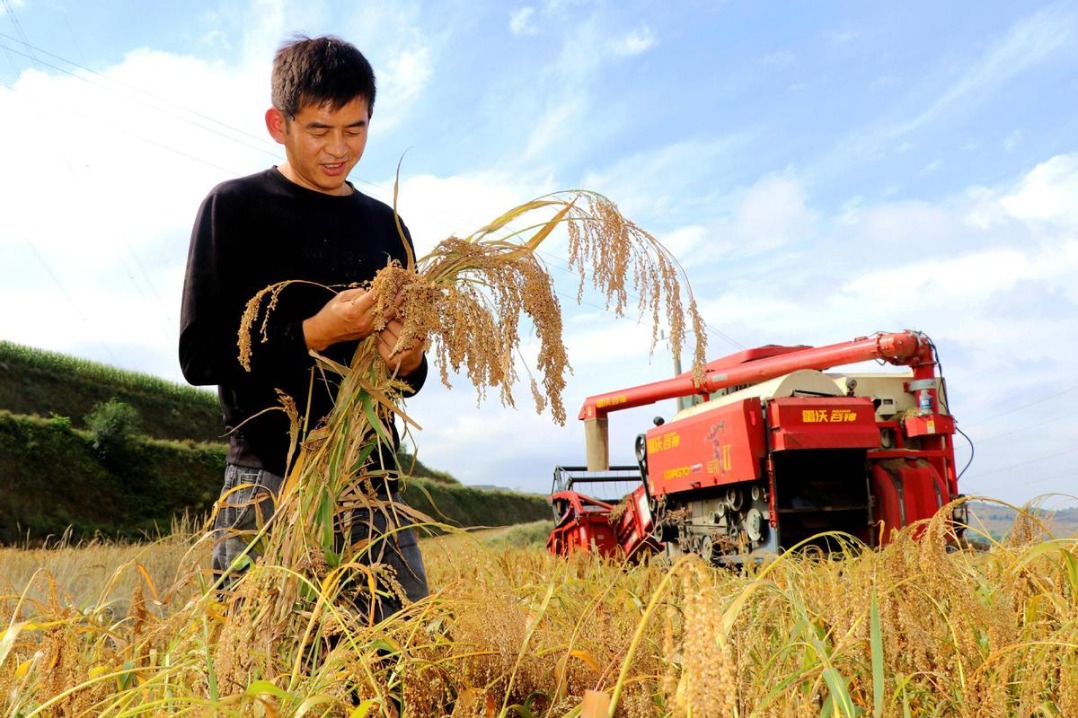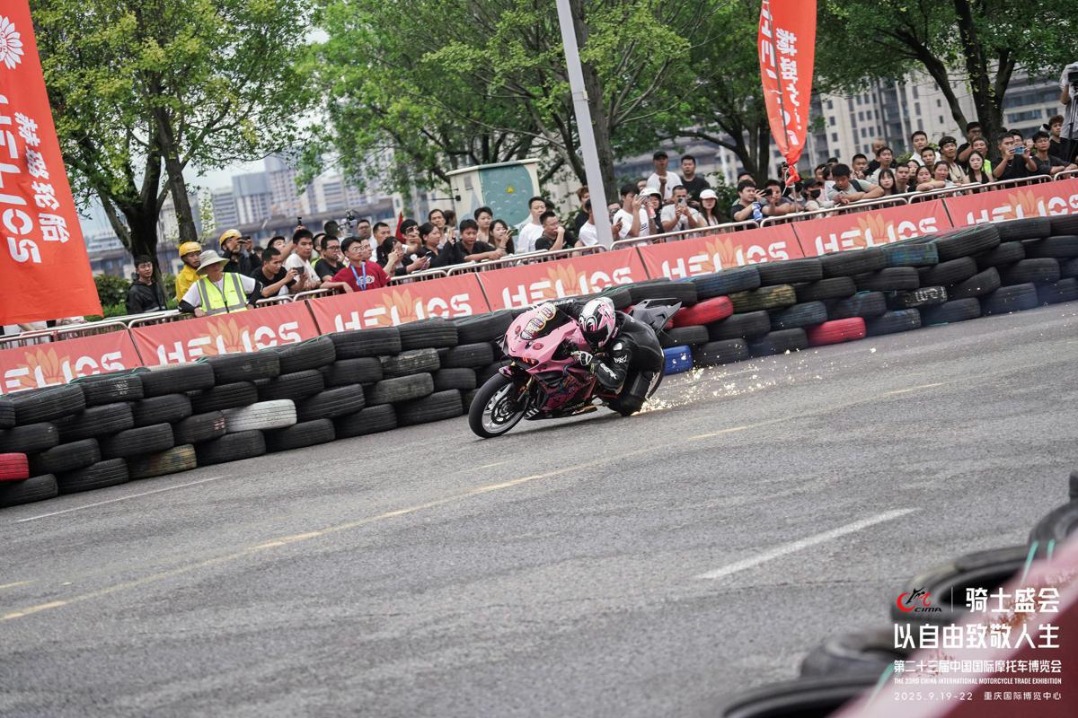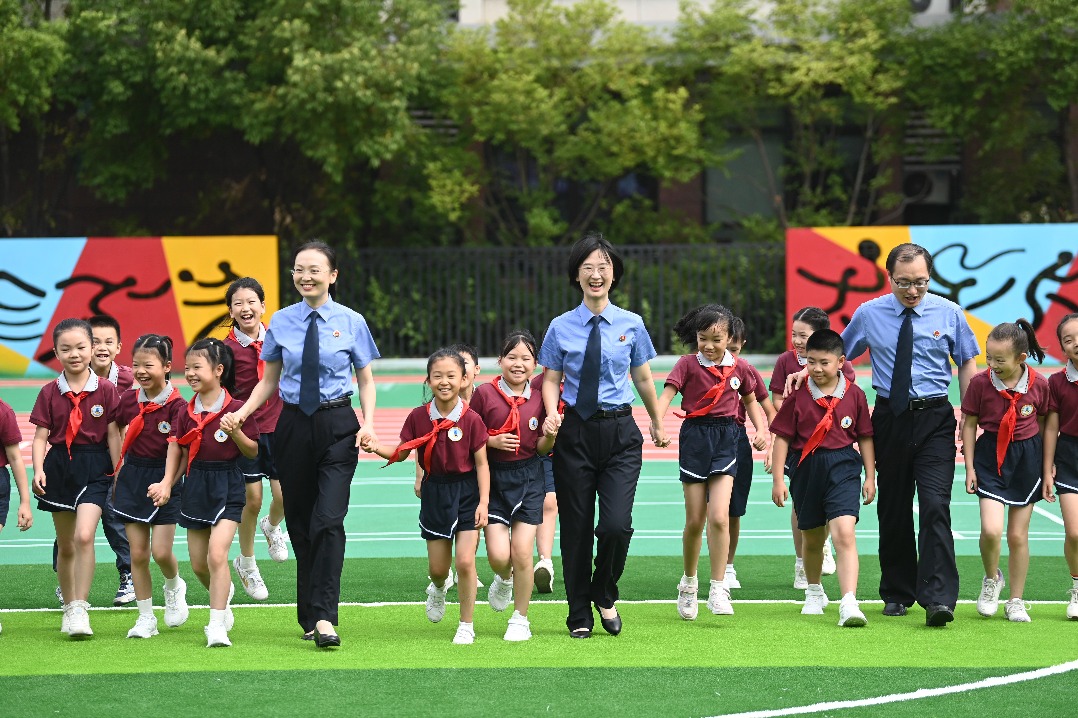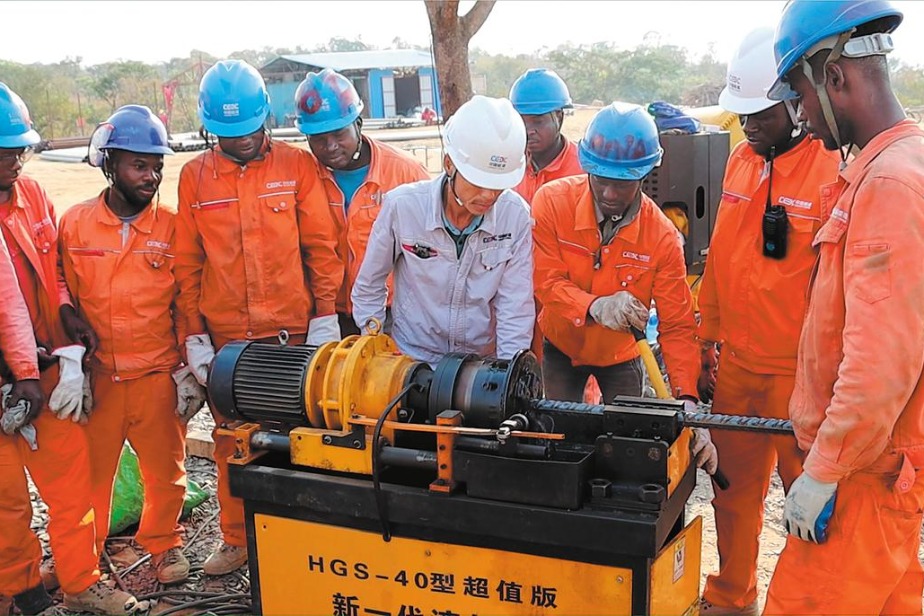Xi Focus: How Xi leads China to feed itself

BEIJING -- The morning news speaks of continuous rainfall, but in the fields of Liaoning province in Northeast China, Zhao Yuguo is calm, his eyes fixed not on the sky, but on a smartphone.
On the screen, temperature and humidity data stream in from sensors across his sprawling 5G digital farm, while a tap on a control screen by his nephew, Zhao Jian, brings a drone to life.
It then skims low over the vast fields, where countless ears of corn are ripening within their green husks. The drone's mission is to protect this future harvest by precisely dropping ping-pong-sized balls that release trichogramma, the natural enemy of the corn borer.
"One drone can cover nearly 20 acres a day -- a tenfold increase in efficiency," he said.
Such quiet confidence is a new phenomenon on a plain where a farmer's wisdom once came from his father and grandfather, not a river of data.
"In the past, a forecast like this would have us worried for days," Zhao Jian said. "You prayed. You hoped. Now, we trust the system."
A LEADER'S VISION, A NATION'S MISSION
The "system" the Zhaos trust is the tangible result of a national strategy championed by President Xi Jinping: "storing grain in the land and in technology."
This strategy confronts a monumental task. China must feed nearly 20 percent of the world's population with just 9 percent of its arable land. This is not just a modern challenge. It's a historical struggle for survival. In ancient China, famines toppled dynasties, and a single natural disaster could leave the fields littered with the starved. Before the founding of the People's Republic of China in 1949, around 80 percent of the country's population lived on the edge of starvation.
The sheer scale of this challenge led US scholar Lester Brown to ask in 1995, "Who will feed China?" He speculated that China's rising food prices will become the world's rising food prices and China's land scarcity will become everyone's land scarcity.
Since the beginning of its reform and opening-up in 1978, the country has historically solved the problem of food shortage for its vast population through rural reform and development. Yet, despite this remarkable success, the modernization of agriculture remains a challenging task for China.
Fully aware of this profound reality, Xi has made issues of agriculture, rural areas, and farmers a top priority. His strategy of improving both land and technology is his answer to this age-old, global challenge.
"Storing grain in the land" manifests as the high-standard farmland the Zhao family works on. Xi has championed the emergence of more leveled, fertile and efficiently irrigated farmland -- resilient in the face of both drought and flood. Buzzing overhead, the drone is a clear example of "storing grain in technology," part of a suite of modern tools, including artificial intelligence-powered analytics, that have transformed farming.
Notably, even the seeds Zhao plants are themselves a product of intense research. Xi underscored this focus on self-reliance in seed technology during a visit to a seed laboratory in the southern island province of Hainan. "Only by holding Chinese seeds firmly in our own hands, can we hold the Chinese rice bowl steady and ensure food security," Xi declared.
A LEADER WITH ROOTS IN THE SOIL
Xi's dedication to this cause is rooted in personal experience. He spent seven years as a young man working the land in the poor village of Liangjiahe in Northwest China's Shaanxi province -- and was deeply moved by the hardships of farmers there.
He still remembers the local saying that painted a grim picture of the changing seasons: "You feast in lunar January, but grow lean by February. By March and April, you're half-starved."
This experience in Shaanxi has resulted in a deep empathy -- evident today in Xi's approach to governance. During an inspection, he once bent down, picked a soybean pod and chewed on a bean to check its quality, earning praise from local farmers as a true expert. An unassuming habit from his early years, this gesture revealed Xi's deep, personal connection to the land and its people.
It is a common sight during his rural inspection tours to see him walk down muddy field ridges, deep into the crops, to listen directly to the farmers at work.
His personal dedication translates into a national focus -- symbolized by the Chinese farmers' harvest festival. The festival, celebrated every year on Sept. 23, is the first national festival created specifically for the country's farmers.
More than just a party, the festival is the nation's way of saying a heartfelt "thank you." It's a moment for everyone from bustling cities to quiet villages to recognize that the nation's prosperity grows from the soil -- and to honor the unwavering hands that feed 1.4 billion people.
Marking the harvest festival each year, from the very first to this year's eighth, Xi has delivered a message celebrating these hard-won harvests. His greetings over the years have ranged from calling for a social atmosphere that cares for farmers, to fostering lives that are more prosperous, happier, and more beautiful. He envisions a future where life for farmers is a story of onwards and upwards.
The president's message on Monday underscores the crucial role of modernizing agriculture and rural areas in advancing China's modernization, calling for delivering real benefits to farmers themselves.
Xi's vision for agriculture is also rooted in a profound respect for the entire food cycle, from the soil to the table. His philosophy is evident in the relentless push to protect the fertile black soil of the northeast -- championing it as a national treasure as precious as the panda. It is also the driving force behind the nationwide "Clean Your Plate" campaign, an initiative he personally advocated to combat food waste, transforming the celebration of a harvest into a daily act of cherishing its bounty.
CELEBRATE HARVEST, CELEBRATE A NEW LIFE
Across the nation, the fruits of this comprehensive strategy are now ripening. Last year, China's grain output exceeded 700 million tonnes for the first time -- underpinned by the development of over 66.7 million hectares of the type of high-standard farmland Zhao works on. Science is increasingly the driver of this remarkable stability -- with the contribution rate of agricultural technology now exceeding 63 percent.
Such progress has not only filled the nation's granaries but has also translated into a steady rise in rural incomes. It creates a tangible sense of security that flows from the fields, fundamentally underpinning the confident hum of city life.
In megacities like Beijing and Shanghai, the outcome is the simple luxury of walking into a supermarket with fully-stocked shelves, of planning family meals knowing that the price of eggs and milk won't unexpectedly double, and of scrolling through delivery apps where "out of stock" notifications are a rarity.
This robust supply chain does more than just enrich Chinese dinner tables. It serves as an anchor of stability for the world. By ensuring the food supply for its 1.4 billion people, China acts as a crucial stabilizing force for global food markets.
But China's contribution extends beyond passive market stabilization. China is also actively sharing its agricultural expertise with other developing nations -- particularly in Africa. According to African experts and organizations like the Alliance for a Green Revolution in Africa, such cooperation is advancing food security and rural development across the continent.
It is achieved through the exchange of technology, the establishment of joint research and training programs, and the sharing of China's own successful model for agricultural modernization. Rooted in a desire to boost local yields and improve rural livelihoods -- these efforts are transforming China's domestic success into a tangible global public good.
This outward-looking confidence is deeply rooted in an internal transformation -- a shift that stands in stark contrast to the humble dreams of the previous generation.
During the 2020 "two sessions," Xi recalled a conversation from his time in Liangjiahe. "One time on an empty stomach, I asked the people around what made an ideal life," he said.
First, they told him, was just enough chaff to eat so they wouldn't have to beg. Second, they craved coarse grains like sorghum and corn. Their third, seemingly unattainable dream, was "to have rice and flour on the table at any time, with a meal of meat regularly."
Xi then urged them to dream higher. The farmers joked they hoped for "carrying a 'golden shoulder pole' to the field in the future."
For generations, the simple wooden shoulder pole, used to carry heavy buckets and baskets, was the ultimate symbol of back-breaking farm labor. The joke envisioned a future with prosperity beyond their imagination, in which this very tool of hardship would be crafted from precious gold.
"I believe the goal is also in the offing. The 'golden shoulder pole,' as I interpreted it, is agricultural modernization," Xi said.
Today, the "golden shoulder pole," once a bittersweet joke born from hardship, has become a tangible reality. It is the hum of the drone soaring over golden fields. It is the stream of data from sensors on a 5G farm. It is the promise held within a single high-yield seed developed in a lab.
For Zhao Jian's generation, farming is no longer drudgery to be escaped, but a tech-driven profession powered by such smart technologies.
"The older generation always worried about how much the harvest would be," Zhao Jian said, looking out at the vast, orderly fields. "We think about how to do it with higher efficiency and better quality. It's a completely different way of life."
- Xi Focus: How Xi leads China to feed itself
- Autumn harvest in China
- HKSAR govt activates emergency monitoring and support center for typhoon Ragasa
- South China's Guangdong raises emergency response to highest for approaching typhoon
- Northern Myanmar criminal group on trial in China over killings, telecom fraud
- Mongolian party leader lauds Shanghai's community-level services






































